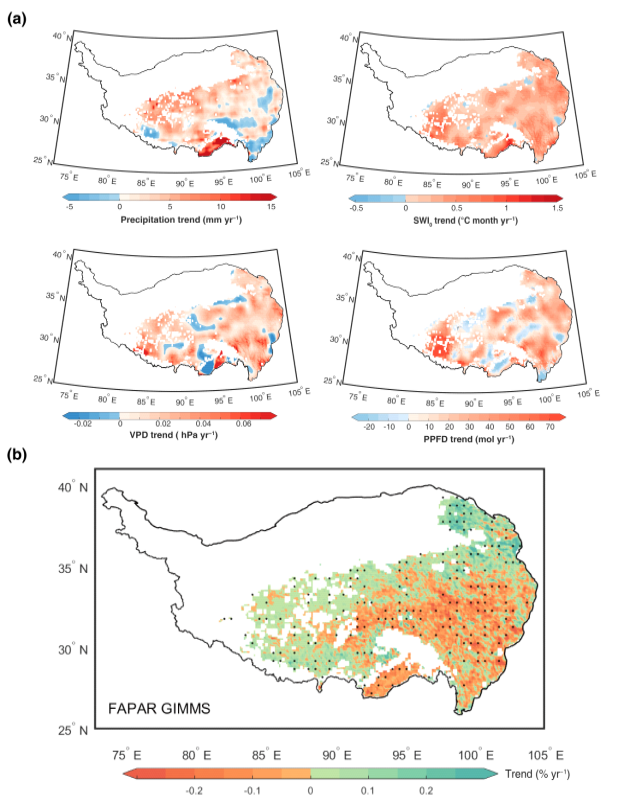Increasing atmospheric CO2 concentration in the midst of global warming has led to increases in vegetation greenness over much of the world. However, recent studies have demonstrated that the trend of global greening appears to be declining for unclear reasons. The Tibetan Plateau particularly sensitive to climate change is a natural testing ground to explore the mechanism of climate affecting vegetation growth. In recent decades, influenced by multiple environmental factors, the vegetation growth characteristics of the Tibetan Plateau have changed significantly. The influence of different environmental factors on vegetation growth is complicated, and the internal mechanism of climate change driving vegetation greenness change in the Tibetan Plateau calls for further study.
Recently, Associate Professor Wang Han's Research Group of the Department of Earth System Science (DESS), Tsinghua University has, in the light of long-time series multi-source satellite remote sensing data and meteorological information, analyzed the temporal and spatial pattern of vegetation greenness response to climate change in Tibetan Plateau from 1982 to 2016. It was found that although the climatic factors such as light, temperature, water and humidity changed relatively uniformly on the whole plateau, the trend of maximum vegetation greenness showed obvious spatial differentiation (Fig. 1). In the northern region, the vegetation turned green significantly; However, in the central and southeast areas, the greenness of vegetation showed a downward trend. In order to explain and attribute this phenomenon, the research group introduced the water balance constraint on the basis of the principle of ecological evolution optimality, and developed a concise leaf area index model, which not only effectively predicted the spatial distribution of the maximum vegetation greenness, but also quantitatively predicted the interannual variation trend of the maximum vegetation greenness on the Tibetan Plateau and its sensitivity in response to climate factors, thus providing a scientific tool for revealing the driving mechanism of the spatial divergence of vegetation greenness on the Tibetan Plateau (Fig. 2). The results have been published in a paper titled "Optimality principles explaining divergent responses of alpine vegetation to environmental change" in Global Change Biology, an international journal.

Fig. 1. Spatial distribution of climate factors and peak vegetation growth in the Tibetan Plateau

Fig. 2 (a) Maximum leaf area index prediction scheme under water balance constraint; (b) Satellite-observed and model-predicted results of the interannual change trends of the vegetation greenness in the Tibetan Plateau
The research group used this model to decouple the contribution of multiple environmental factors to vegetation greenness change, and explored the driving mechanism of vegetation greenness change in the Tibetan Plateau. The results showed that the rising atmospheric carbon dioxide concentration improved the utilization efficiency of light energy and water by vegetation, and promoted the growth of vegetation in the Tibetan Plateau. On the basis of this effect, water further dominated the change of vegetation greenness in arid areas of northwest China, which made the vegetation in this area turn green as a whole with the increase of precipitation. However, in relatively humid areas, temperature and air dryness were the main factors affecting vegetation growth. With the increase of temperature and air dryness, the biomass distributed by vegetation to the ground increased, which in turn increased the carbon cost per unit leaf, not conducive to the growth of vegetation canopy in this area (Fig. 3). Meanwhile, the results of observation and model prediction showed that the sensitivity of vegetation growth in the Tibetan Plateau to precipitation and temperature had decreased over the past few decades, with the observed decreases being 0.00054 % mm−1 yr−1 and 0.10 % SWI−1 yr−1,respectively, consistent with the predicted results (0.00057 % mm−1 yr−1 and 0.06 % SWI−1 yr−1). This showed that the limiting ability of water on the growth of alpine vegetation would gradually weaken with the increase of precipitation, while the increase of atmospheric dryness caused by warming and the adjustment of carbon distribution above and below ground might weaken the growth of vegetation canopy.

Fig. 3 Attribution of trends in peak vegetation cover to various factors
Zhu Ziqi, a doctoral student in the DESS, Tsinghua University, is the first author of the paper, and Associate Professor Wang Han is the corresponding author. Dr. Qiao Shengchao, postdoctoral fellow Tan Shen, and distinguished visiting professors Sandy P. Harrison and I. Colin Prentice of Tsinghua University, are the co-authors of the paper. The research is supported by the National Natural Science Foundation of China (32022052, 91837312, 31971495) and the Independent Scientific Research Program of Tsinghua (20223080041).
Full-text link:
Zhu, Z., Wang, H., Harrison, S. P., Prentice, I. C., Qiao, S., & Tan, S. (2022). Optimality principles explaining divergent responses of alpine vegetation to environmental change. Global Change Biology, 00, 1– 17. https://doi.org/10.1111/gcb.16459
Written by Zhu Ziqi